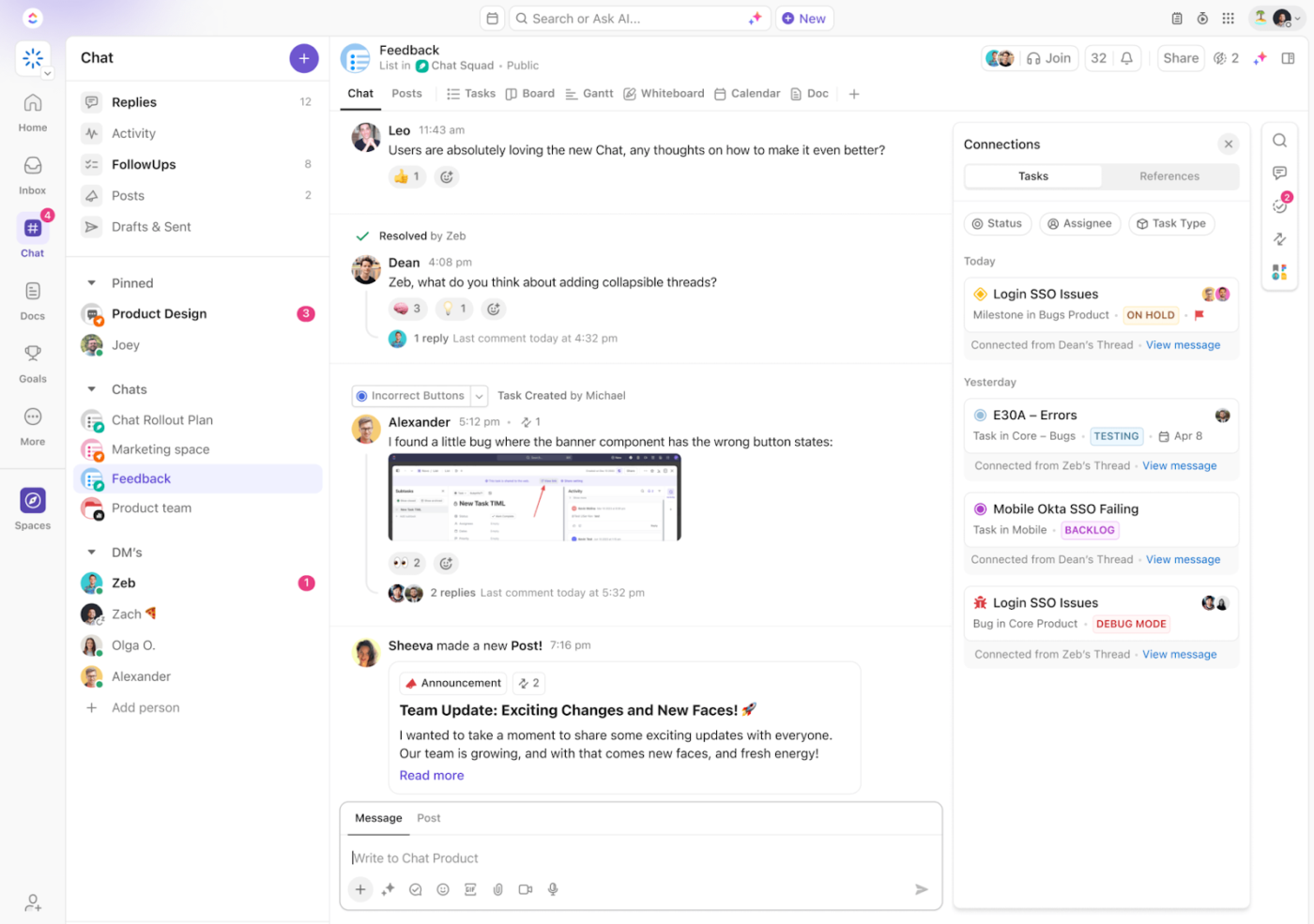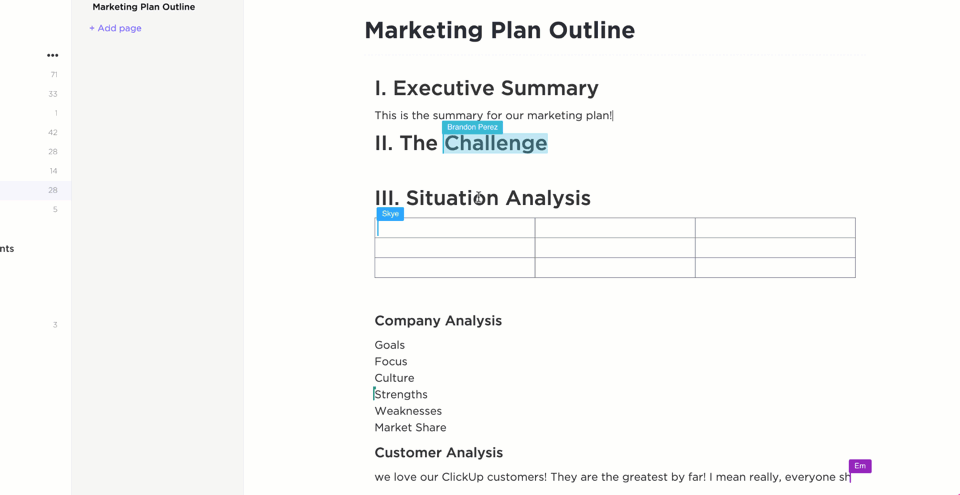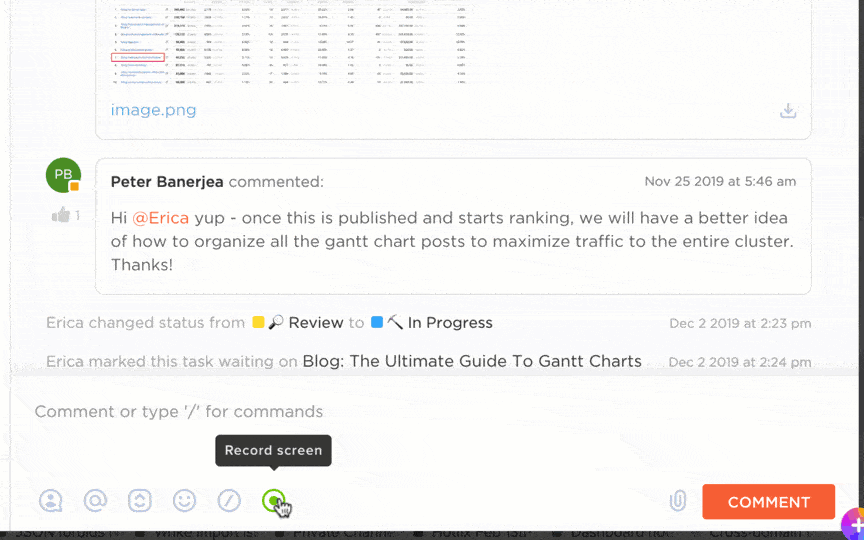Microsoft Teams Pricing: Plans, Features and Alternatives

Sorry, there were no results found for “”
Sorry, there were no results found for “”
Sorry, there were no results found for “”

Professionals in pretty much any industry know the value of Microsoft Teams. It makes workplace communication easy. And since it caters to small businesses and large enterprises, it offers various pricing structures.
But how do these plans compare? Is the price worth the features you’re getting? Are there better Microsoft Teams alternatives? Let’s break it down.
| Feature | Microsoft Teams | ClickUp |
|---|---|---|
| Purpose | Communication-focused | All-in-one work management |
| Task Management | Requires add-ons (Planner, MS Project) | Built-in with Lists, Boards, Gantt, etc. |
| Docs | Limited via OneNote/Word | Native Docs with AI, real-time editing, task linking |
| Meetings | Chat and video; Copilot extra | Built-in meeting tools, AI Notetaker, async Clips |
| Visual Collaboration | Separate Whiteboard app | Built-in Whiteboards connected to tasks |
| Automation | Via Power Automate (complex) | Built-in, easy-to-use automations |
| Integrations | Strong with Microsoft apps | 1000+ integrations including Teams, Zoom, Slack |
| Pricing | Add-ons needed for full functionality | Flexible plans designed to scale with your team’s needs |

Think of Microsoft Teams as your digital office space. It combines team communication tools—chat, video meetings, file sharing, and app integration—into one.
You can highlight important updates, share files in the conversation, and split discussions into focused team channels. This file-sharing software automatically stores documents from chat to SharePoint and OneDrive, keeping everything organized.
Microsoft Teams also has a built-in audio and video call system to make remote meetings more human. You can use its AI-powered noise cancellation to block out background noise and enjoy crystal-clear conversations.
After scheduling meetings, you can track them on your Teams calendar and sync with Outlook. Its AI-powered Microsoft Copilot helps you summarize meetings, generate action items, and draft responses within chat.
If you use multiple tools, Microsoft Teams integrates with other Microsoft apps, such as Word and Excel, and third-party tools.
📚 Related Read: Microsoft Teams Hacks, Tips, and Tricks to Try
The Microsoft Teams pricing structure can be a little complicated. But don’t worry. We’ll tell you precisely what each tier offers and help you make smart budget decisions. Here’s an overview of each MS pricing plan to pick a plan with features that match your needs.
The Microsoft Teams free plan suits small teams and personal projects with basic requirements.
Who’s it for? This plan is suitable for basic collaboration needs without complex requirements.
This plan combines Teams with web versions of popular Microsoft Office apps.
Bonus: Learn how to keep your Teams status green!
Who’s it for? This plan is helpful for small businesses and startups that need an online meeting tool but don’t want the full Microsoft 365 package.
This plan combines Teams with web versions of popular Office apps.
Who’s it for? This plan will benefit small to mid-sized companies that need online meeting tools and basic Office apps.
Teams needing all the features and advanced tools should consider this plan.
Who’s it for: Medium to large-sized businesses that heavily use Office apps and need advanced security will benefit from this solution.
Microsoft Teams has multiple pricing plans, but does its cost match your needs? Let’s discuss the pros and cons of its pricing strategy.
The Microsoft Teams plans have compelling benefits, making it an attractive choice. You can:
Unfortunately, MS Teams has quite a few drawbacks when it comes to its cost structure.
🤓 Did you know? Microsoft Teams was originally built as a response to Slack, and developed in just a few months after Microsoft’s bid to buy Slack fell through in 2016.
While Teams integrates smoothly with Microsoft products, connecting it with non-Microsoft tools can be tricky. This could limit your growth.
Here are four key reasons to consider Microsoft Teams alternatives:
Microsoft Teams pricing plans vary from free to premium paid plans like Microsoft 365 Business Standard. However, some users might find that the required features are only available in higher-tier plans, which can be prohibitive.
If your organization doesn’t need all the bundled services, you’d still have to pay for more than you use.
Microsoft Teams’ interface packs many features, which can overwhelm users, particularly those new to the ecosystem. Setting it up can be very time-consuming, as no pre-existing structure exists.
You must create channels, determine their names, and align them with relevant teams from scratch. Creating a copy of these channels is also a manual task.
MS Project (a Microsoft Teams project management software product) is a task management integration system. However, you must purchase a separate license to use MS Teams for project management.
This can challenge smaller teams or those working within a budget. The learning curve is also steep, requiring you to learn multiple applications to fulfill task requirements.
MS Teams caps private channels at 30. For user management, a maximum of 250 members are allowed, with a 200 standard channel limit per team.
This might seem like a lot at first, but imagine a consulting firm where each client project needs its own standalone channel—they might reach this limit faster than expected.
👀 Did You Know? 67% of businesses have implemented new collaboration tools post the COVID-19 pandemic.
Workers toggle between apps 1,200 times a day—nearly 4 hours a week in attention resetting.
Projects, knowledge, and communication scattered across disconnected tools can slow you down. In fact, teams using multiple tools experience higher collaboration challenges, such as a lack of alignment, miscommunication, and trust issues, on top of feeling overwhelmed.
ClickUp can quickly and easily fix this for you. ClickUp combines task management, project management, chat, docs, whiteboards, meetings, and automation in a single platform. This means you don’t need to switch between multiple tools for communication, documentation, and task tracking—everything is centralized.
Imagine your deadline is in an hour. Your tasks are in one app, chats in another, and the latest project timeline is buried in an email thread. With ClickUp, you can link tasks, docs, and timelines in one view, find the updates, and submit your project on time.
While Microsoft Teams focuses mainly on communication, ClickUp brings all your operations under one roof. It offers deeper project and task management, built-in docs, and more robust workflow automation. And, if you’re not yet ready to forgo Teams, you can also use the ClickUp Microsoft Teams integration without having to switch.
For teams using MS Teams as their business messaging app, ClickUp handles project updates, tasks, and discussions in one place—no more scattered information—just organized teamwork.
Here’s how Microsoft Teams integration in ClickUp can be useful:

ClickUp Chat connects conversations to tasks, projects, and documents to brainstorm.
Unlike MS Teams, which focuses primarily on discussions, ClickUp attaches context to each chat, making it easier to turn conversations into action items and develop effective communication strategies.
Why ClickUp Chat stands out:


While MS Teams offers Microsoft Whiteboard as an external tool, ClickUp has a native solution. Users can brainstorm and plan with ClickUp Whiteboards. It helps teams map out ideas, workflows, and strategies in real time.
You can link tasks directly from the whiteboard and convert ideas into actionable tasks within the same interface.
Additionally, Whiteboard is integrated with ClickUp Chat and ClickUp Project Management. This tool’s dynamic nature improves communication by connecting tasks visually across your workspace, giving your team a chance to brainstorm and collaborate in the same place.
ClickUp Meetings provides a central spot for storing your notes, action items, and follow-ups and helps you stay organized and accountable. ClickUp AI Notetaker automatically transcribes meetings, summarizes key points, and generates actionable meeting notes—saving your team time and ensuring nothing gets missed.
Here’s how you can host effective meetings:
📮ClickUp Insight: 37% of workers send follow-up notes or meeting minutes to track action items, but 36% still rely on other, fragmented methods. Without a unified system for capturing decisions, key insights you need may get buried in chats, emails, or spreadsheets.
With ClickUp, you can instantly turn conversations into actionable tasks across all your tasks, chats, and docs—ensuring nothing falls through the cracks.

Teams never have to switch between multiple tools to manage their work in ClickUp. You can create and assign tasks from chat, link them to relevant discussions, and collaborate with your team members in ClickUp Docs.
Team members can work together on Docs in real time using features like typing indicators, comments, and revision tracking. ClickUp Docs also comes with ClickUp AI, which can help with content writing, summarizing, and translating.

To view your work and manage your tasks, you can use ClickUp’s Calendar.
The ClickUp Calendar spots scheduling conflicts, tracks project progress, and adjusts timelines within its ecosystem. Unlike Microsoft Teams’ basic calendar integration, ClickUp’s calendar is more intuitive and offers task-focused scheduling.
You can overlay personal, team, and external calendars (Google, Outlook, Apple) in one view to see all commitments in one place. This allows you to instantly identify which tasks are in progress, overdue, or completed using custom color-coded views.

For teams that rely on video communication, ClickUp Clips represents a holiday from everyday meetings.
With these, you do not have to worry about maintaining virtual meeting etiquette. Record tutorials or instructions using ClickUp Clips and create a library of important discussions for future reference.
Also Read: Free Screen Recorder No Watermark Tools

In case of a problem, instead of sending a separate email or pinging a colleague in a different chat, you can use ClickUp Assign Comments to direct the query to them.
Additionally, ClickUp Integrations centralize all your conversations and project-related discussions, helping you stay organized.
For example, the ClickUp Zoom Integration allows you to start a Zoom call right from a ClickUp task. You can also link meeting recordings and summaries to projects.
Meanwhile, the ClickUp Slack Integration lets you create tasks from Slack messages with one click and sync discussions between the two platforms.
ClickUp offers flexible pricing plans that cater to teams of all sizes, providing a cost-effective alternative to Microsoft Teams. Here is the detailed breakdown of the plans:
The free forever plan includes core project management tools that many teams need.
Key features
Who’s it for? Perfect for small teams, freelancers, or individuals starting with project management tools who want essential features without cost
This plan has none of the free tier limits, giving teams more flexibility.
Key features
Who’s it for? Small to mid-sized teams needing a complete project management solution without breaking the bank
The Business plan adds advanced features that Microsoft Teams lacks, such as burndown charts for Scrum teams and custom reporting.
Key features
Who’s it for? Mid-sized teams using Scrum or needing detailed project analytics and reporting
The Enterprise plan adds corporation-level security and customization with features suitable for large organizations.
Key features
Who’s it for? Large organizations with advanced security, customization, and dedicated support requirements
Take a look at all aspects of ClickUp’s pricing here
Lewis Norwood, Head of Client Relations at Pharmacy Mentor, says:
ClickUp has helped our business become much more productive—saving time, reducing the need for pointless meetings, and vastly increasing employee and client satisfaction.
MS Teams is suitable for those already embedded in the Microsoft ecosystem. You can communicate with others using chat and video options and create focused channels to divide workflow. However, its lack of task management features can be a hurdle for many.
Handling task assignments and progress tracking requires additional tools like Planner or Project, whereas ClickUp comes with built-in task lists, Kanban boards, Gantt charts, and workload views.
Investing in multiple tasks and team management tools can increase overhead expenditures and create confusion. Opting for one platform that integrates everything eliminates these roadblocks.
Sign up for ClickUp for free and work smarter.
© 2025 ClickUp